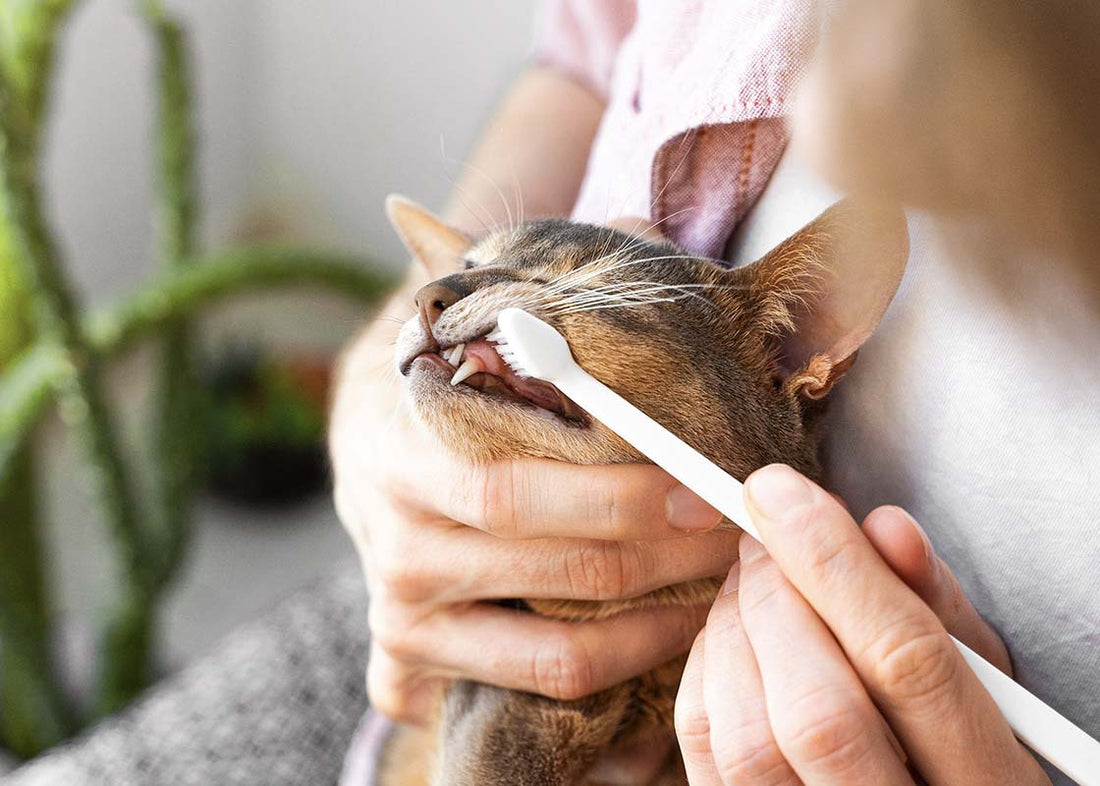Tartar in cats: How to keep your cat's teeth healthy
Tartar – a problem that's not only familiar to humans. Tartar is also a common culprit in cats, and can lead to pain, tooth loss, and even inflammation in the body over time. But don't panic! With proper cat dental care, you can prevent or eliminate tartar and make your cat's life easier.
In this article, I'll explain how to recognize tartar in your cat, what you can do about it, and which simple care measures can help prevent the problem from occurring in the first place.
What is tartar and how does it form in cats?
Tartar is a stubborn coating that forms from soft plaque. Minerals in saliva cause this plaque to harden into a solid layer that primarily deposits on the tooth surfaces and gum line .
Causes of tartar in cats:
- Incorrect diet: Soft food hardly contributes to teeth cleaning.
- Genetic predisposition: Some cats are more prone to tartar formation.
- Poor dental hygiene: Without dental care, bacteria have an easy time.
- Age: Older cats are more likely to develop dental problems.
Detecting tartar in cats – The most important symptoms
Tartar can be detected with the naked eye if you know what to look for. Check your cat's mouth regularly to intervene early.
Typical signs of tartar in cats:
- Yellowish-brown deposits on the teeth
- Bad breath (unpleasant, foul smell)
- Redness and swelling of the gums
- Bleeding gums
- Gum inflammation (gingivitis)
- Your cat is reluctant to chew or eats more slowly
Important: Tartar builds up gradually. The longer it goes untreated, the more damage it causes.
Dangers of tartar: Why you should act
Tartar in cats isn't just a cosmetic problem. If left untreated, it can have serious health consequences:
- Gingivitis: Tartar irritates the gums and leads to inflammation (gingivitis).
- Periodontitis: Untreated tartar attacks the tooth roots and causes tooth loss.
- Pain: Your cat is suffering without you even noticing.
- Bacterial infections: The bacteria can enter the blood and damage the heart, liver or kidneys.
Removing tartar: What to do if your cat has tartar?
If your cat already has tartar, it's usually not easy to remove at home. A veterinarian can help:
1. Professional dental cleaning at the vet:
- The veterinarian removes tartar using special equipment, often under anesthesia.
- Costs: Between 80 and 200 euros, depending on the effort and region.
2. Aftercare at home:
After tartar removal, it is important to care for your teeth regularly to prevent new plaque from forming immediately.
Home remedies for tartar: Does it really help?
Tartar can't simply be magically removed. However, there are home remedies that can help:
- Tooth-cleaning snacks: Special chew snacks can reduce plaque.
- Coconut oil: A touch of coconut oil applied to the teeth has an antibacterial effect.
- Dental care gels: These gels slowly dissolve plaque and tartar.
Important: Home remedies are primarily helpful for prevention – existing tartar must be removed professionally.
Preventing tartar: The best tips for cat dental care
Prevention is the best way to avoid tartar in your cat. Here are the most important tips:
1. Brush your teeth:
- Get your cat used to brushing its teeth slowly. Special toothbrushes and toothpaste for cats are ideal.
- Start gently with short sessions and increase slowly.
2. Dentally healthy diet:
- Offer your cat dry food or raw meat pieces to encourage chewing and clean teeth.
- Avoid sugary food – it promotes plaque!
3. Tooth-cleaning snacks:
- Special chew snacks or toys support mechanical tooth cleaning.
4. Regular checks:
- Check your cat's teeth regularly to detect tartar early.
- An annual check-up with the veterinarian helps prevent dental problems.
Gingivitis: A common problem in cats
Tartar and gingivitis often go hand in hand. Inflamed gums are painful, bleed easily, and cause unpleasant bad breath.
Symptoms of gingivitis:
- Red, swollen gums
- Loss of appetite
- Excessive salivation
- bad breath
Treatment:
The veterinarian will clean the teeth and, if necessary, prescribe anti-inflammatory drugs or antibiotics.
How often should you check your cat's teeth?
- Weekly: A quick look into the mouth helps to detect changes early.
- Every six months: If you suspect dental problems, you should visit your veterinarian.
- Annually: A dental check-up at the vet is part of the routine examination.
Conclusion: Tartar in cats – prevention is better than cure!
Tartar in cats is a serious problem that shouldn't be ignored. You can do a lot to prevent tartar buildup through regular checkups, proper dental care, and a healthy diet.
The most important points at a glance:
- You can recognize tartar by yellowish deposits and bad breath.
- Professional teeth cleaning is often unavoidable.
- Dental care at home is the key to prevention.
- Get your cat used to brushing its teeth early on to avoid long-term problems.
A healthy mouth means a happy cat life – so get that toothbrush out! 🐾



